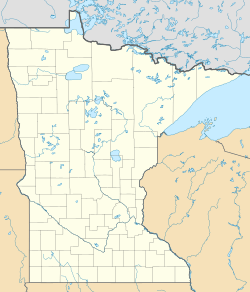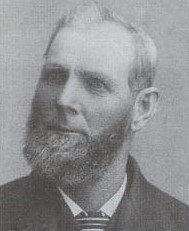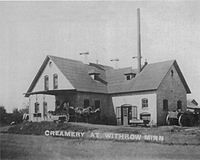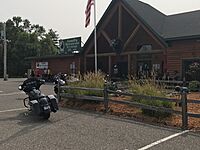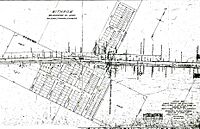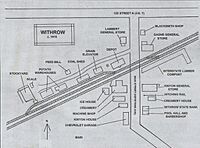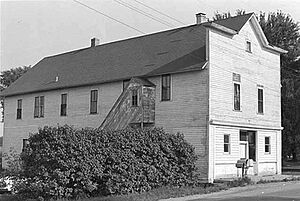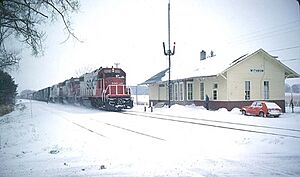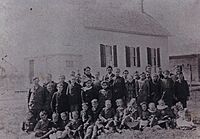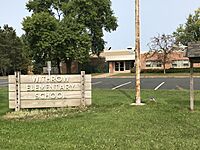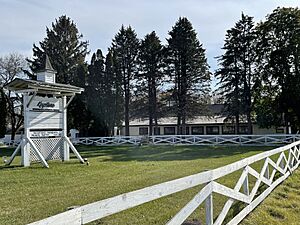Withrow, Minnesota facts for kids
Quick facts for kids
Withrow, Minnesota
|
|
|---|---|
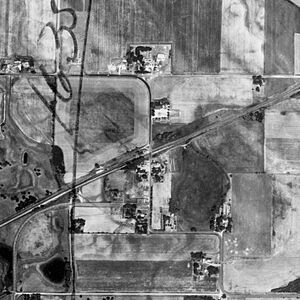
Aerial photo of Withrow in 1964
|
|
| Country | United States |
| State | Minnesota |
| County | Washington County |
| Elevation | 981 ft (299 m) |
| Time zone | UTC−6 (Central (CST)) |
| • Summer (DST) | UTC−5 (CDT) |
| ZIP code |
55038 and 55082
|
| Area code(s) | 651 |
| GNIS feature ID | 654293 |
Withrow is a small place in Washington County, Minnesota, United States. It's called an unincorporated community, which means it's not an official city or town with its own local government. Withrow is located inside the city of Grant.
Long ago, Withrow was a small village on the edge of the Minneapolis–St. Paul area. It used to be part of three different local areas: May Township, Grant Township, and Oneka Township. The village had a post office and a general store in May Township. It also had a train station in Oneka. Withrow is about 6 miles (9.7 km) northeast of White Bear Lake and 6.4 miles (10.3 km) northwest of Stillwater.
Withrow started in 1883 when a railroad line was built through Washington County. The village was named after Thomas Joshua Withrow, a farmer from Nova Scotia who moved there in 1874. The soil around Withrow was good for growing potatoes. Withrow was officially mapped out in 1914, but it never became an official city. In 1947, a request to make it a city was turned down because it didn't have enough people. Many early settlers in the area were from France (French-Canadian), Ireland, and Germany.
Today, the main part of Withrow is usually thought of as the place where Keystone Avenue North and 119th Street North meet. Parts of Withrow were later included in nearby cities. For example, a part became part of Hugo in 1972, and another part became part of Grant in 1996. A small piece of Withrow is still in May Township. This area has the Keystone Weddings and Events Center (which used to be the Withrow Ballroom) and a cemetery.
The Stillwater Area School District had an elementary school in Withrow until 2017. Now, Withrow is seen as a distinct area with homes and businesses, rather than an official village. It has a few small businesses, a private school, and some houses.
Contents
History of Withrow
The areas that now include parts of Withrow were first surveyed, or mapped, in 1847 and 1848.
The Withrow Family
The settlement of Withrow was named after Thomas Joshua Withrow. He was an important early settler in the area.
How Withrow Grew
The Minneapolis & St. Croix Railroad came through Washington County in 1883. This led to the creation of the village of Withrow. In 1896, a cooperative creamery was built. A creamery is a place where milk is processed into butter and cheese. This creamery brought many farmers to the area every day.
An ice house was located behind the creamery. It stored large blocks of ice cut from School Section Lake, about 1 mile (1.6 km) north of Withrow. This ice kept the butter cool, especially in warm weather. The Withrow Creamery became famous when it won second prize for best creamery butter at the St. Louis World's Fair in 1904.
South of the creamery, the Interstate Lumber Company had a machine shop. This shop sold farm equipment and repair parts. After the lumberyard burned down in 1944, the machine shop building was used for many different things. It became a place that made fiberglass toboggans, a cabinet shop, a home, a beauty shop, a convenience store, and two taverns. In 2003, it became part of Sal's Angus Grill. The lumber company also had a coal shed near the train station.
By the early 1900s, Withrow had several general stores. These stores sold many different things like food, produce, and farm tools. A blacksmith was also in town, fixing wagons and making metal items. There were also warehouses to store large bags of potatoes before they were shipped by train.
A barbershop and pool hall was a popular spot. You could get a haircut, play pool, eat a sandwich, and buy ice cream there. Next to it was the Withrow State Bank, built in 1913. The bank closed in 1923. Later, the building was used as a home and then as the post office. By 1910, Withrow also had a Chevrolet car dealership and garage.
Withrow was a busy community when trains were the main way to ship goods. However, in the 1920s, roads got better. Farmers started driving their own potatoes and cattle to market. Milk companies from Minneapolis–St. Paul began picking up milk directly from farms. Because of this, the grain elevator and the cattle stockyard in Withrow closed down.
The only church in the area was St. Matthew's Lutheran church, built by German settlers. The original wooden church was built in 1874. It was replaced by a brick church in 1899, which burned down in 1904 after being struck by lightning. It was rebuilt without its steeple. Today, this church is home to the St. Croix Ballet.
Between 1900 and 1950, when Withrow had its largest population, it had a baseball team called the Gophers. There were also many clubs like the Woodmen of the World Camp, a Mothers club, a 4-H club, and a Community Club. The Community Club was a big part of social life. It held monthly meetings and dances. The club ended in 1949 as people lost interest. Withrow also had a Girl Scout troop until 1978 and a Boy Scout troop until 2012.
Withrow is a popular place for people who like to ride bicycles and motorcycles. In the 1970s, the March of Dimes used the old Chevrolet garage as a checkpoint for their Bike-A-Thon fundraisers. Many bicycle clubs still use a 13-mile (21 km) route that starts and ends at the former Withrow Elementary School. The Warlords motorcycle club started in Withrow in 1972.
The Withrow Post Office
Withrow had its own official U.S. post office from 1890 to 1963. After that, it was a rural branch office until 1966. The post office first opened on June 11, 1890, inside the B. W. Ellis general store.
In 1909, a fire destroyed the store and the post office documents. After the fire, Clarence LeRoy Kinyon reopened the store and post office. He sold hardware, groceries, and clothes. The post office moved a few times, including to the old Withrow State Bank building and then to the Kinyon house. In 1962, the post office moved to the old creamery building, which also became the Withrow Tavern and a small grocery store. Mail delivery was later taken over by a rural route carrier. The Kinyon general store building was destroyed by fire in 1981.
Railroads in Withrow
The growth of the lumber industry led to many new towns and railroads. The Minneapolis & St. Croix Railroad came through Washington County in 1883. In 1888, this railroad joined with others to form the Soo Line Railroad.
Two train lines met in Withrow, making it an important train and telegraph station. In 1887, a train station (depot) was built. It was much larger than the village ever needed. At one point, the railroad had people working at the station 24 hours a day. It was a very busy place, with almost thirty freight trains and passenger trains passing through daily. It was also a favorite rest stop for travelers riding the trains.
As the railroad era ended, Withrow lost many of its businesses. The Soo Line stopped passenger service to Withrow in 1963. In July 1990, the Withrow depot was torn down.
Schools in Withrow
Before 1955, there were three small schools in the Withrow area. They were usually one-room schoolhouses. One of these, School #51, was built in 1871. The first teacher was Mary Withrow, and it had 32 students. This school later became known as the Kinyon School.
In 1952, the Stillwater area school board decided to build a new, larger elementary school in Withrow. The new school was built in 1955 on land that used to belong to Thomas Withrow. It had three classrooms, a kindergarten, and a multi-purpose room. Over the years, more parts were added to the building. In 2008, Withrow Elementary was used as a filming location for the movie Killer Movie.
Withrow Elementary was part of the Stillwater Area School District. It taught 219 students from kindergarten through sixth grade. It was a STEM school, focusing on Science, Technology, Engineering, and Math. It was ranked highly among elementary schools in Minnesota. In 2012, it was named a National Blue Ribbon School by the U.S. Department of Education.
In 2015, the school district planned to close Withrow Elementary and two other schools. This was because of low student numbers in the northern part of the district. Parents protested, worrying that their children would do worse in larger schools. Despite these protests and legal challenges, Withrow Elementary closed on May 31, 2017.
In 2021, a private school called Liberty Classical Academy bought the empty Withrow Elementary School building.
The Withrow Ballroom
The old Kinyon general store had a dance hall on its second floor. Dances were held there on Saturday nights and were very popular. However, the dance hall was later closed because it was a fire hazard.
Bernard and Anna Zahler decided to build a new ballroom. They bought an old grain elevator, took it apart, and used the wood to build Zahler's Withrow Ballroom in 1928. It was built on the site of the old blacksmith shop. This ballroom is the oldest in Minnesota. The first dance was held on the Fourth of July. Admission was 25 cents, and soft drinks were five cents. They also sold "near beer," which was a non-alcoholic drink popular during Prohibition.
The 10,000 square foot (930 m2) ballroom is known as a great place for live music in the Twin Cities area. The Zahlers sold the ballroom to their son, Ed Zahler Sr., in 1946. Ed Zahler Sr. got a license to sell mixers for drinks in 1950. He continued the tradition of polka dances, but also started playing rock and roll music in the late 1950s. His son, Ed Zahler Jr., bought the ballroom in 1974. He added windows, food, and a kitchen, and made it available for weddings.
After three generations of the Zahler family owned it, the ballroom was sold to Marvin and Mary Jane Babcock in 1983. They renamed it the "Withrow Ballroom." Later, their son Mark and his wife Lori took over. Mark Babcock changed the look of the ballroom to resemble a Kentucky horse farm.
The ballroom was sold again in 1997 and 2001. The new owners in 2001 added dance lessons and planned to expand the ballroom into a conference center, motel, bar, and restaurant. However, the ballroom closed on November 1, 2008, because of the great recession.
In 2009, Paul Bergmann bought the ballroom. He added dinner theater and classic car shows. He sold it in 2017. In 2019, Lawrence Xiong bought the building and renamed it the Keystone Wedding and Events Center.
Many famous musicians have played at the Withrow Ballroom, including the Six Fat Dutchmen, the Lamont Cranston Band, Bobby Z., Yanni, and Jonny Lang. It has also hosted music festivals, fundraisers, weddings, and other events.
Geography and Nature
Withrow is located in a natural area called the Eastern Broadleaf Forest Province. This area has oak woodland, oak savanna, and prairie. When the area was first settled, there were many scattered oak trees, some brush, and occasional pines, maples, and basswoods. Today, the land is mostly used for cultivated crops, pasture, and hay. There are also scattered forests of oak and aspen, hazelnut bushes, and open prairie areas. A group of black walnut trees grows along the east side of Keystone Avenue.
Brown's Creek starts near Withrow. The rocks under Withrow are part of large, gently sloping layers of sandstone, shale, and carbonate rock.
Withrow's Climate
Withrow has a cool climate with big temperature differences between summer and winter. Winters are very cold, and summers are fairly short and warm. Snow usually covers the ground from late fall to early spring.
- Average summer temperatures (June-August) are about 70°F (21°C).
- Average winter temperatures (December-February) are about 18°F (-8°C).
- July is the warmest month, with an average high of 80°F (27°C) and a low of 63°F (17°C).
- January is the coldest, with an average high of 21°F (-6°C) and a low of 3°F (-16°C).
Withrow is located at an elevation of 981 feet (299 m) in Washington County, Minnesota. It is about 15 miles (24 km) northeast of St. Paul. Withrow is 6 miles (9.7 km) northeast of White Bear Lake and 6.4 miles (10.3 km) northwest of Stillwater. It is 2.9 miles (4.7 km) north of Minnesota State Highway 96 and 5.2 miles (8.4 km) east of U.S. Highway 61. The last time Withrow appeared on the Official Minnesota State Highway Map was in 2012.


